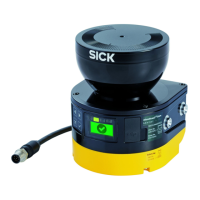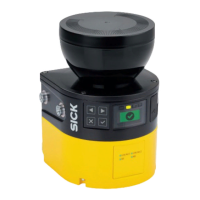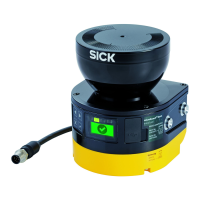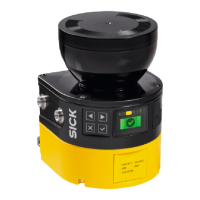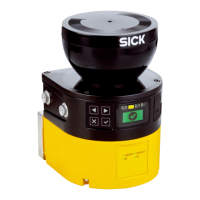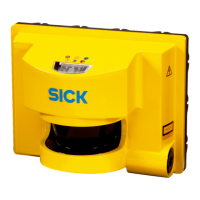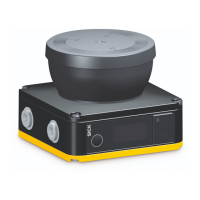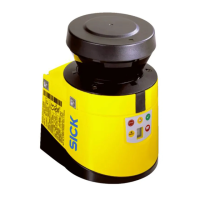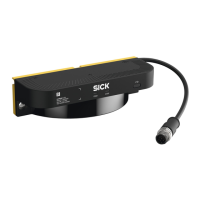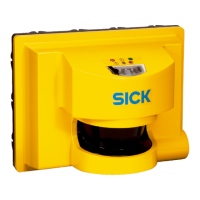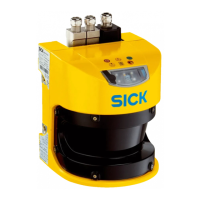17 List of figures
1. Laser class 1M............................................................................................................10
2. Principle of time-of-flight measurement....................................................................13
3. Light pulses scan an area.......................................................................................... 14
4. Device overview.......................................................................................................... 15
5. Status LEDs.................................................................................................................16
6. Protective field, shown in red in this document........................................................19
7. Reference contour field, shown in blue-green in this document.............................19
8. Warning field, shown in yellow or orange in this document.....................................20
9. Field set, consisting of one protective field (red) and 2 warning fields (orange and
y
ellow)..........................................................................................................................21
10. Monitoring case 1 with field set 1............................................................................. 21
11. Monitoring case 2 with field set 2............................................................................. 22
12. Hazardous area protection: detection of the presence of a person in the haz‐
ardous area.................................................................................................................22
13. Hazardous point protection: Hand detection............................................................23
14. Access protection: detection of a person when accessing a hazardous area........23
15. Mobile hazardous area protection: detection of a person when a vehicle
approaches................................................................................................................. 24
16. Prevent crawling beneath...........................................................................................26
17. Prevent stepping over.................................................................................................27
18. Unsecured areas.........................................................................................................28
19. Mounting with deflector plates (example).................................................................29
20. Mounting in an undercut (example).......................................................................... 29
21. Mounting in vehicle paneling (example)....................................................................30
22. Tolerance band of the reference contour field (protective field within the protected
opening, edge of the protected opening = reference contour)................................32
23. Overrun of the protective field in front of an opening.............................................. 32
24. Stationary application with horizontal scan plane for hazardous area protection.34
25. Protection against reaching over when mounted low (dimensions in mm)............ 37
26. Protection against reaching over when mounted high (dimensions in mm).......... 37
27. Scan plane at ankle height........................................................................................ 38
28. Scan plane at calf height........................................................................................... 39
29. Distance of the protective field from the wall...........................................................40
30. Stationary application in vertical operation for hazardous point protection.......... 41
31. Stationary application in vertical operation for access protection..........................44
32. Mobile application in horizontal operation for hazardous area protection.............46
33. flat-rate supplement ZF for lack of ground clearance..............................................47
34. Minimum supplement for lack of ground clearance................................................ 48
35. Stopping distance as a function of the vehicle’s speed...........................................49
36. Recommended fitting height..................................................................................... 51
37. Recommended fitting height for inverted mounting................................................ 51
38. Dual-channel and isolated connection of OSSD1 and OSSD2................................54
39. No potential difference between load and protective device.................................. 54
40. How the restart interlock works (1): no one in protective field, machine operates
..................................................................................................................................... 57
41. How the restart interlock works (2): person detected in protective field, safety out‐
put in OFF state.......................................................................................................... 58
42. How the restart interlock works (3): person in hazardous area, no detection in pro‐
tective field, safety output still in OFF state..............................................................58
43. How the restart interlock works (4): the reset pushbutton must be pressed before
restarting the machine...............................................................................................59
44. Connection diagram with restart interlock and external device monitoring (EDM)60
45. Prevent crawling beneath...........................................................................................66
46. Prevent stepping over.................................................................................................66
LIST OF FIGURES 17
8025870/2020-09-04 | SICK O P E R A T I N G I N S T R U C T I O N S | microScan3 Core I/O
163
Subject to change without notice
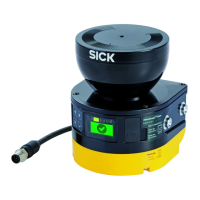
